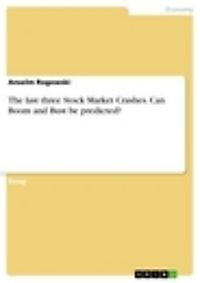Technical stock market anomalies literature review
A question that has been subject to extensive research and debate is whether past prices and charts can be used to predict future prices.
Common techniques include strategies based on relative strength, moving averages, as well as support and resistance. The majority of researchers that have tested technical trading systems and the weak-form efficient market hypothesis have found that prices adjust rapidly to stock market information and that technical analysis techniques are not likely to provide any advantage to investors who use them.
However others argue that there is validity to some technical strategies. Two of the most visible participants in the debate are Princeton Professor Burton Malkiel author of A Random Walk Down Wall Street and Mark Hulbert. There has been a remarkable uniformity in the conclusions of studies done on all forms of technical analysis. Not one has consistently outperformed the placebo of a buy-and-hold strategy.
Hulbert disagrees with the "Not one" statement and as backup for his argument, Hulbert refers to a study by William BrockJosef Lakonishokand Blake LeBaron 1 BLL. The authors analyzed moving averages and trading range breaks on the Dow Jones Industrial Index from to The technical rules addressed in the study were the following.
Buy and sell signal were generated by a long and short moving average crossing.
They tested long moving averages of 50, and days with short averages of 1, 2 and 5 days. The results - "All the buy-sell differences are positive and the t-tests for these differences are highly significant A buy signal was generated when the price penetrated the resistance level and a sell signal was generated when the price penetrated the support level. Technical analysts believe that investors sell at the resistance level and buy at the support level.
The results for both buy and sell signals supported the technical viewpoint. However, transactions costs should be carefully considered before such strategies can be implemented. It is quite possible that technical rules pick some of the hidden patterns. We would like to emphasize that our analysis focuses on the simplest trading rules. The work of LeBaron and Brock was also referred to in the October 9, Frontiers of Finance Survey in The Economist.
Some technical analysis forex ppt from the article included: Contrary to previous tests, they found that both types of rule work quite well.
The previous conclusion that technical analysis is useless was, in the words of Dr Brock and Dr LeBaron, "premature".
Data-Snooping, Technical Trading Rule Performance, and the Bootstrap was an article that revisited the Technical stock market anomalies literature review paper and later appeared in the October Edition of Journal of Finance.
In the article, Ryan Sullivan, Allan Timmermann, and Halbert White STW attempt to how to make the best lancashire hotpot the effect of Data-Snooping on the BLL results.
They also use data collected from the period following the original study in order to provide an out of sample test. Adding the recent years provided a full years of data. STW calculated a break even transaction cost level of 0. STW found "that the results of BLL appear to be robust to data-snooping.

However, we also find that the superior performance of the best trading rule is not repeated in the out-of-sample experiment covering the period " and "there is scant evidence that technical trading rules were of any economic value during the period Another technical analysis debate is whether strong performance from one period continues or reverses in future periods.
Some studies have concluded that positive correlation exists winners repeat in the short term weeks and months while negative autocorrelation exists over longer periods of time See Neglected Stocks. O'Shaughnessy claims in What Works on Wall Street that relative strength is a strong indicator of future performance.
His criteria was strong performance for the calendar year. Several studies have found that firms reporting unexpectedly high earnings outperform those reporting poor earnings and the outperformance continues for the following six months See announcement based effects.
Investor Home - Anomalies
Momentum Strategies 2 was a comprehensive review and analysis of the subject in the December issue of the Journal of Finance. The authors note that any excess returns from "momentum strategies" may not be fully capturable because of trading costs particularly with smaller issues. Geert Rouwenhorst published a paper titled International Momentum Strategies in The Journal of Finance that documented momentum strategies in 12 European markets from Other articles include Global Momentum Strategies by John Griffin in the Journal of Portfolio Management WinterProfitability of Momentum Strategies: An Evaluation of Alternative Explanations from Narasimhan Jegadeesh and Sheridan TitmanPrice Momentum and Trading Volume from Charles M.
Lee and Bhaskaran Swaminathan OctoberBad News Travels Slowly: Size, Analyst Coverage, and the Profitability of Momentum Strategies from Harrison Hong, Terence Lim, and Jeremy C. Stein Januaryand Do Industries Explain Momentum by Tobias J. Moskowitz and Mark Greinblatt August
